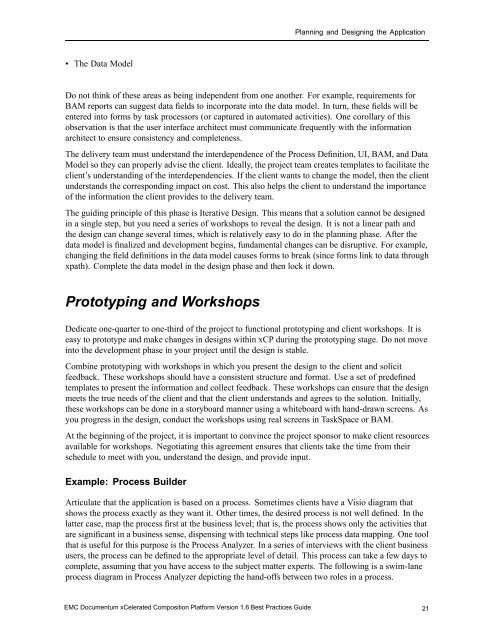Designing processes - EMC Community Network
Designing processes - EMC Community Network
Designing processes - EMC Community Network
Create successful ePaper yourself
Turn your PDF publications into a flip-book with our unique Google optimized e-Paper software.
Planning and <strong>Designing</strong> the Application<br />
• The Data Model<br />
Do not think of these areas as being independent from one another. For example, requirements for<br />
BAM reports can suggest data fields to incorporate into the data model. In turn, these fields will be<br />
entered into forms by task processors (or captured in automated activities). One corollary of this<br />
observation is that the user interface architect must communicate frequently with the information<br />
architect to ensure consistency and completeness.<br />
The delivery team must understand the interdependence of the Process Definition, UI, BAM, and Data<br />
Model so they can properly advise the client. Ideally, the project team creates templates to facilitate the<br />
client’s understanding of the interdependencies. If the client wants to change the model, then the client<br />
understands the corresponding impact on cost. This also helps the client to understand the importance<br />
of the information the client provides to the delivery team.<br />
The guiding principle of this phase is Iterative Design. This means that a solution cannot be designed<br />
in a single step, but you need a series of workshops to reveal the design. It is not a linear path and<br />
the design can change several times, which is relatively easy to do in the planning phase. After the<br />
data model is finalized and development begins, fundamental changes can be disruptive. For example,<br />
changing the field definitions in the data model causes forms to break (since forms link to data through<br />
xpath). Complete the data model in the design phase and then lock it down.<br />
Prototyping and Workshops<br />
Dedicate one-quarter to one-third of the project to functional prototyping and client workshops. It is<br />
easy to prototype and make changes in designs within xCP during the prototyping stage. Do not move<br />
into the development phase in your project until the design is stable.<br />
Combine prototyping with workshops in which you present the design to the client and solicit<br />
feedback. These workshops should have a consistent structure and format. Use a set of predefined<br />
templates to present the information and collect feedback. These workshops can ensure that the design<br />
meets the true needs of the client and that the client understands and agrees to the solution. Initially,<br />
these workshops can be done in a storyboard manner using a whiteboard with hand-drawn screens. As<br />
you progress in the design, conduct the workshops using real screens in TaskSpace or BAM.<br />
At the beginning of the project, it is important to convince the project sponsor to make client resources<br />
available for workshops. Negotiating this agreement ensures that clients take the time from their<br />
schedule to meet with you, understand the design, and provide input.<br />
Example: Process Builder<br />
Articulate that the application is based on a process. Sometimes clients have a Visio diagram that<br />
shows the process exactly as they want it. Other times, the desired process is not well defined. In the<br />
latter case, map the process first at the business level; that is, the process shows only the activities that<br />
are significant in a business sense, dispensing with technical steps like process data mapping. One tool<br />
that is useful for this purpose is the Process Analyzer. In a series of interviews with the client business<br />
users, the process can be defined to the appropriate level of detail. This process can take a few days to<br />
complete, assuming that you have access to the subject matter experts. The following is a swim-lane<br />
process diagram in Process Analyzer depicting the hand-offs between two roles in a process.<br />
<strong>EMC</strong> Documentum xCelerated Composition Platform Version 1.6 Best Practices Guide 21

















